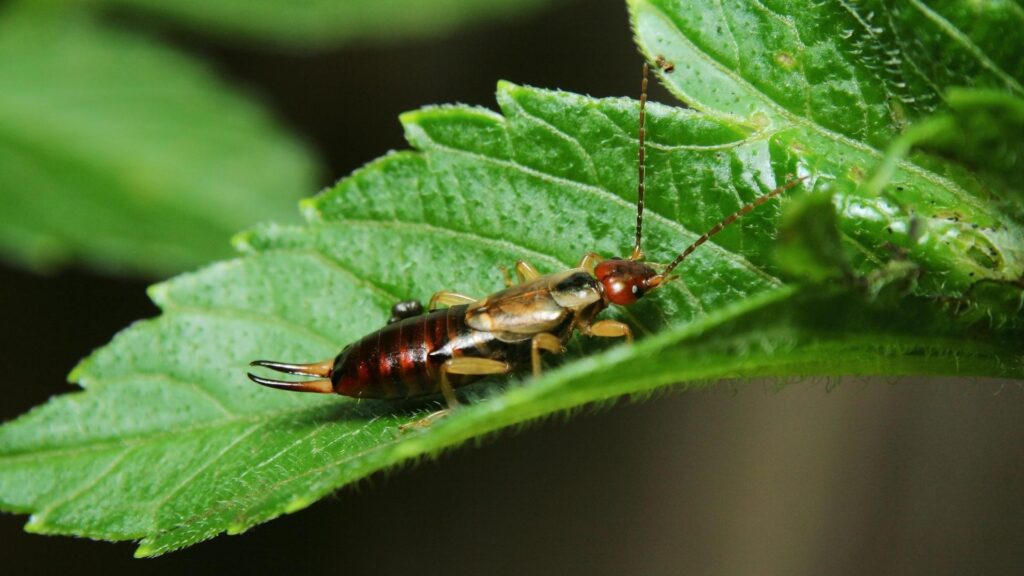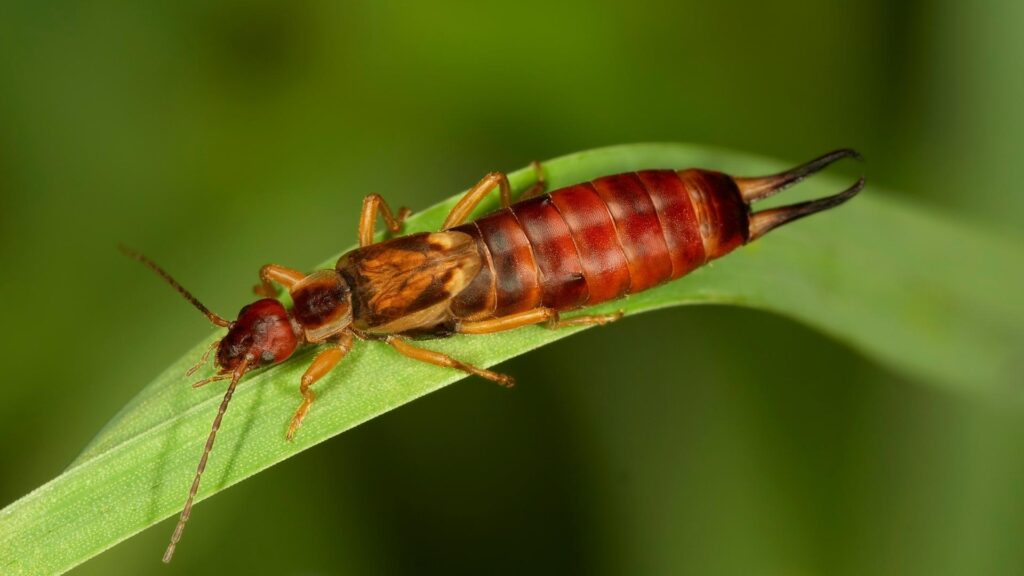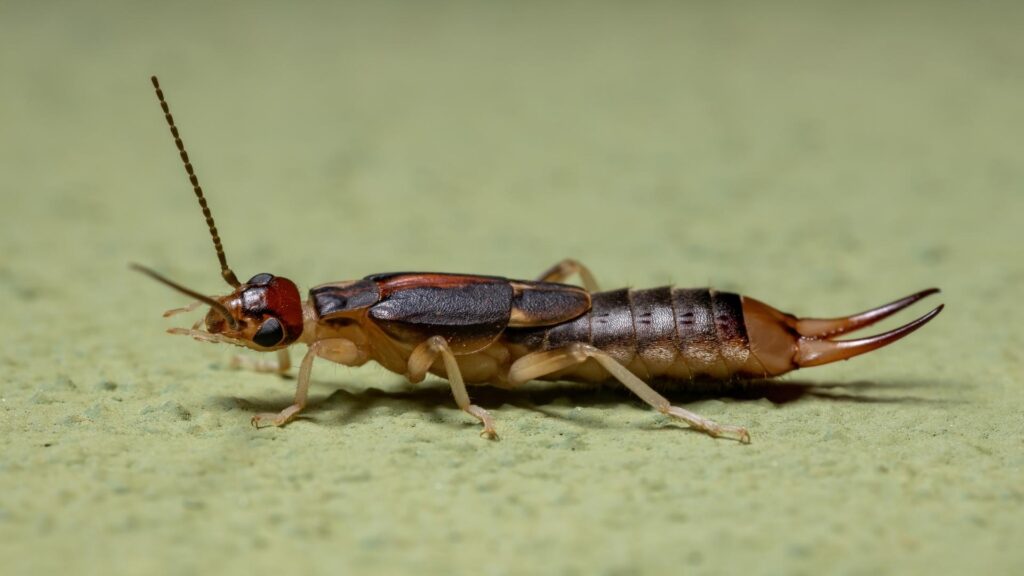Have you ever heard of earwigs? These insects are infamous because of creepy stories narrating how they enter your ear and lay eggs inside your brain. But is all that true? Or is it just a myth?
Earwigs are insects belonging to the Dermaptera order and are known to prey on decaying matter. While they have an intimidating pincer, earwigs are non-aggressive if you leave them alone. Contrary to popular belief, they do not go in your ear.
There’s so much more to learn about earwigs. While they’re generally considered pests, they play a role in cleaning out the environment. And if you’re looking for ways to naturally get rid of them, continue reading to know more.
Table of Contents
What Are Earwigs?

Earwigs are insects belonging to the Dermaptera order of insects. With large pincers at the tip of their bodies, these insects look like they’re always ready to put up a fight. However, the opposite is true – earwigs are non-aggressive and would only use their pincers to protect themselves against predators.
Interestingly, earwigs are nocturnal beings known to feast on decaying organic matter like dead insects and fallen leaves. However, they also eat fruits, leaves, and other vegetation when it’s available. That can cause great damage to your garden.
Fortunately, there are ways to prevent an earwig infestation in your home and garden. This will be discussed at length later on in this article.
What Do Earwigs Look Like?
Earwigs are small insects with reddish-brown to dark brown bodies. They have long slender bodies that are supported by three pairs of legs. Interestingly, their legs have a more pale and translucent color which contrasts their dark-colored bodies. On average, an earwig can be ¼ to 1 inch long, depending on its subspecies.
A notable feature of the earwig is its pair of pincers. It is located at the tip of its body and often curves slightly upward. While these pincers look intimidating, earwigs only use them to defend themselves. And like most insects, earwigs also have a pair of thread-like antennae at the top of their heads.
The earwig’s scientific name is Dermaptera, which comes from the Greek words derma meaning “skin” and ptera, meaning “wings.” This is so because these insects have short membranous wings under forewings, hence the name.
Why Do Earwigs Have Pincers?
Earwigs have pincers. In fact, an earwig’s pincers is one of its most iconic features because not a lot of insects have them.
Being non-aggressive insects, earwigs often use their pincers for defending themselves against attackers and predators. Aside from a defense mechanism, these pincers also play a part in their mating process. It has been observed that male earwigs would use these forceps to attract females.
Additionally, you can determine the gender of the earwig just by looking at its pincers. Generally, males have larger pincers that tend to curve inwards. In contrast, females have short and straight pincers.
Can Earwigs Fly?
Some earwigs can fly. However, a majority of earwig species are not considered flyers.
While these insects have wings, most earwigs rarely use their wings for flight. However, it has been observed that the Lesser earwig subspecies are capable of slow flying, especially considering their unique folding wings.
Also, studies reveal that an earwig’s wings do not have internal muscles, so controlling them during flight can be quite a challenge. That’s why earwigs rarely fly high or cover long distances.
Where to Find Earwigs?
Earwigs thrive in moist environments. This is why you will often find them hiding inside crevices, fallen debris, tree barks, shrubs, and on moist soil in garden pots.
Earwigs also love mold so they can be found almost anywhere that’s damp and moldy. This includes dilapidated structures, especially those made of wood.
What is the Lifespan of an Earwig?
On average, an earwig can live for around one year. Within its year of life, an earwig goes through three stages: the egg stage, the nymph stage, and the adult stage.
Earwig eggs usually take 7 days before they begin to hatch. After this, baby earwigs will spend around 40 to 60 days before developing into adults. During this nymph stage, baby earwigs will molt 4 to 5 times before they become adults.
And finally, the adult earwig can survive for around 170 days. During this stage, their reproductive organs are fully developed, making them ready to mate. However, earwigs can live longer or shorter, depending on the subspecies and their environment.
Why Do They Call Earwigs?

Earwigs derive their name from the Old English words “eare” meaning “ear” and “wicga,” meaning “insect.” Thus, they were called ear insects, which sometimes translates to ear creatures or ear wigglers.
The etymology behind the name is believed to be due to stories that earwigs would often crawl inside people’s ears and lay eggs inside. However, it remains unfounded to this day.
Do Earwigs Actually Go In Your Ear?
Earwigs do not go inside your ear. Fortunately, earwigs do not climb into people’s ears nor do they decide to lay eggs there.
While earwigs are small enough to crawl into one’s ears, they do not do so purposefully. This belief remains unfounded and has been continuously dismissed as a myth.
Are Earwigs Dangerous?

Earwigs are not dangerous. They do not bite. If they did, they have no venom to inject into your bloodstream.
However, they can pinch you with their pincers, and that can easily cut through your skin. But even then, earwigs have still considered a harmless species. After all, they would only attack when they feel threatened.
But while earwigs are not dangerous, they can cause quite the damage to your crop. This is especially true in the case of an infestation.
Can Earwigs Infest Your House?

Earwigs can infest your house. Generally, earwigs are outdoor pests. However, they can easily enter and build a nest in your home if it was accidentally brought indoors, such as when they’re carried in, while hiding inside potted plants, boxes, or newspapers. They can also make their way through your home when a plant’s foliage is touching the door or the window of your home.
Bear in mind that earwigs love moist and moldy areas, especially if they can find a place where they can hide in peace. With that said, they can easily live in cracks, holes, and similar crevices inside your home.
What Are Earwigs Attracted To?
- Dark and damp areas. Earwigs are nocturnal insects that thrive in moist environments. This is why they’re mainly attracted to dark and damp areas.
- Decaying matter. Whether it’s dead insects or fallen leaves, earwigs love feasting on decaying matter. So if your garden isn’t cleaned regularly, expect earwigs to start living there soon enough.
- Flowers, plants, and other crops. Aside from decaying matter, earwigs feast on flowers, plants, and other crops. So if their primary source of food is unavailable, they’ll surely munch on the available vegetation.
- Mold. Molds thrive in humid areas, which is a trait they share with earwigs. That’s why you would often see molds and earwigs in dilapidated wooden structures.
What Smell Keeps Earwigs Away?

- Peppermint. Peppermint smells fresh and relaxing, but it surprisingly irritates insects such as earwigs. Peppermint also releases quite a strong scent, so it will surely keep earwigs away.
- Eucalyptus. Eucalyptus is another refreshing scent that seems to drive earwigs away. Eucalyptus has an astringent odor that is effective at keeping earwigs and other insects away.
- Cinnamon. Cinnamon has a sweet and spicy scent that undeniably smells delicious. However, earwigs find the smell harsh and irritating, which is why they tend to avoid it.
- Basil. If you’re looking for an organic option you can easily plant in your garden, basil is the way to go. Earwigs find basil to be quite pungent, so they never go near its plant.
How to Get Rid of Earwigs in Potted Plants?
Since earwigs love moist and dark areas, they tend to settle inside the water-catching saucers inside potted plants. To get rid of earwigs, simply observe the following steps:
Step 1: Take the plant out and shake it to get rid of earwigs.
Step 2: Drain the water from the saucer. Let it dry completely before placing it back inside the pot.
Step 3: Check the soil if it has earwigs. Then, removes them before putting the plant back.
Step 4: To avoid recurrence, make sure to get rid of weeds and fallen leaves from the plant. These will surely attract earwigs and start another infestation.
How to Get Rid of Earwigs Naturally?
Earwigs can be considered pests, especially if they start destroying your crops. However, there’s no denying that they also help clean out the environment, so it’s best to simply drive them away instead of completely killing them. Here are some of the ways to get rid of earwigs naturally:
- Plant more peppermint and basil. The smell of peppermint and basil drives earwigs away. If you have these plants in your garden, they won’t even bother to go near them.
- Put cinnamon sticks next to your plants. Earwigs hate cinnamon, so you can get rid of them naturally by placing cinnamon sticks around your garden, especially next to those that they love munching on.
- Get a pet chicken. Chickens are foragers who love eating bugs like earwigs. So if you have a pet chicken, just let them forage in your garden, and they’ll surely get rid of your earwig problem.
- To prevent a potential infestation, always make sure that your garden is always clean. Get rid of dead insects and rake out fallen leaves as soon as possible to prevent drawing an earwig’s attention.
- Always trim plants or bushes that tend to reach the walls, doors, or windows of your home. Once the foliage touches your home, it serves as a bridge for earwigs to start infesting your home.
- If all else fails, you can sprinkle Food-grade Diatomaceous Earth around your garden. This non-toxic powder helps get rid of excess moisture in the soil, thus making earwigs dehydrated. Diatomaceous earth also scratches earwigs, so they’re bound to leave your garden as soon as you sprinkle it.
What Are Earwigs Good For?
Earwigs are given the nickname “environmental janitors” for a reason. Their primary source of sustenance is decaying matter. That makes them great for cleaning out fallen leaves, rotting fruits and vegetables, dead plants, and dead insects.
What Does Earwig Poop Look Like?
Earwig poop looks like tiny black pellets. These droppings often look like back-colored termite frass and may even be mistaken for black sand, dirt, or coffee grounds. So if you find these tiny pellets around your home, there’s a chance that earwigs are hiding inside cracks or crevices inside your home.
Where Do Earwigs Lay Their Eggs?
Female earwigs lay eggs in hidden and protected areas, and this includes underneath wet leaves, inside a small burrow in the soil, or in someplace dark and hard to reach.
Surprisingly, earwigs have strong maternal instincts and are known to protect their young. This is why they prefer to give birth in areas that are not easy to find.
Are There Any Benefits to Earwigs?
While earwigs are often considered pests, there are some benefits to having them around. Here are some that easily come to mind:
- They can help clean up decaying plants and insect material. This means that they play an important role in making the environment a cleaner place.
- They prey on other insect eggs and larvae. As a result, they are already killing some pests before they reach adulthood.
What Eats Earwigs?
Earwigs are small insects, and that means they are often preyed upon. The following are among the known predators of earwigs:
- Birds. Birds love feasting on insects, and that includes earwigs. Particularly, birds like chickens, chickadees, and nuthatches love to prey on earwigs.
- Lizards. A lizard’s diet consists mostly of insects, and that includes earwigs.
- Frogs. Like lizards, frogs prey on a variety of insects. If they come across an earwig, they won’t think twice about catching it with their long sticky tongue and eating it.
- Yellowjackets. Being a small insect species, earwigs fall prey to larger insect species like yellowjackets.
- Insect-eating arthropods. Earwigs are also the common food of most insect-eating arthropods like centipedes and spiders.
Do Spiders Eat Earwigs?
Spiders eat earwigs. Spiders primarily prey on insects, and they won’t hesitate to eat an earwig that’s been trapped in its web.
While earwigs may look creepy, you shouldn’t let their exterior fool you. These nocturnal insects love munching on decaying organic matter, so they play a role in cleaning out the environment. But, always make sure to observe proper garden maintenance to avoid earwig infestation. Otherwise, you’ll have to worry about them munching on your crops.
List of Sources
Deiters, J., Kowalczyk, W., Seidl, T. (2016). Simultaneous optimisation of earwig hindwings for flight and folding. Biology open.
Shetlar, D. J., Andon, J. E. (2010). Earwigs. Ohio State University Extension.
Hahn, J., Pellitteri, P. (2019). Earwigs. University of Minnesota Extension.
Earwigs (Family Forficulidae). (2008). University of Wisconsin-Milwaukee.